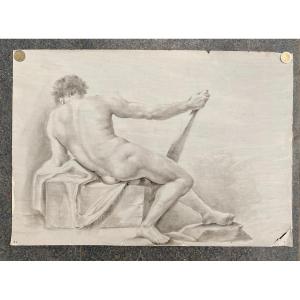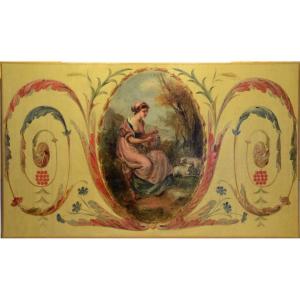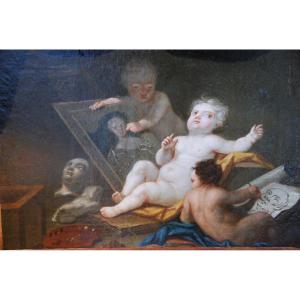Oil on wood in very good condition signed with the monogram DM at the right.
Wooden frame and stucco in good condition.
Frame 41x46 cm
Wooden panel 27x31 cm
Jean-Louis de Marne, sometimes spelled Demarne or Demarnette, is a French painter and engraver, born in Brussels in 1752 and died on March 24, 1829 in Paris.
Some art critics believed, because J.-L. de Marne was born in Brussels, to be able to attribute a Flemish origin to his ancestry. If de Marne was born by chance in Brussels, it is because his parents, like all military households, often had to change garrison. His father Jean-Joseph was an officer in the service of the Emperor of Austria and had married Anne-Ernestine-Christine, née Baroness de Ausechutz.
After his father's death, he arrived in Paris at the age of twelve. He spent his youth there, studying the history painter Gabriel Briard in 1769-1770. He failed the Prix de Rome in 1772 and 1774.
It was then that he turned to genre painting. He was inspired, like Nicolas Antoine Taunay and Jean-Frederic Schall, by the Dutch painters who were in vogue in Paris at the beginning of the 19th century.
He was approved in 1783 at the Academy as an animal painter and exhibited at the Salon. He then spent time with Taunay in Switzerland.
On 7 January 1788, Jean-Louis de Marne married Olive Le Grand in Saint-Eustache, originally from Dieppe and ten years his junior. They had three children.
He worked for the porcelain factory Dihl and Guérhard, using the paint developed by Christophe Dihl, about which the painter and art critic Charles-Paul Landon noted that it allowed for meticulous execution and gave a scintillating effect.
He had the use of accommodation with a studio at the "Musée des Arts" at the Sorbonne from 1801 until at least 1819 and more probably until 1821, the year when all the artists were evicted from the old Sorbonne to make way for the Faculty of Theology.
On April 23, 1828, by royal decree, he was named a knight of the Legion of Honor.
Jean-Louis de Marne died in Batignolles on March 23, 1829, at the age of eighty-five, and was buried in the Père-Lachaise cemetery (28th division).
His daughter Anne Caroline Demarne married the painter Pierre-Rémy Robert (c. 1783-1832), future head of the glass painting workshop at the Sèvres porcelain factory.
He painted a host of genre paintings in which characters, animals and landscapes blend together to recreate the bustling, rural atmosphere of an 18th-century fair, and the calm of a paved country road.
For his genre and cabaret scenes, he drew inspiration from minor Dutch masters of the 17th century such as Paulus Potter, Dirck van Bergen and Adriaen Van de Velde (Acrobats in Front of an Inn, 1824, Musée de Grenoble). His landscapes are as realistic as those of Lazare Bruandetou by Georges Michel (Le Coup de vent, 1817, Musée de Dijon).
He also took part in Pre-Romanticism insofar as he did not turn to Antiquity, but rather to the Middle Ages and the 17th century.
He also happened to play the role of chronicler of his time. Thus, on March 27, 1806, an official letter from Vivant-Denon, general director of the Musée Napoléon, informed him that the Emperor had chosen him to paint the Interview of Napoleon and Pius VII in the Forest of Fontainebleau, November 24, 1804, 1808, Musée national de Fontainebleau.










































 Le Magazine de PROANTIC
Le Magazine de PROANTIC TRÉSORS Magazine
TRÉSORS Magazine Rivista Artiquariato
Rivista Artiquariato